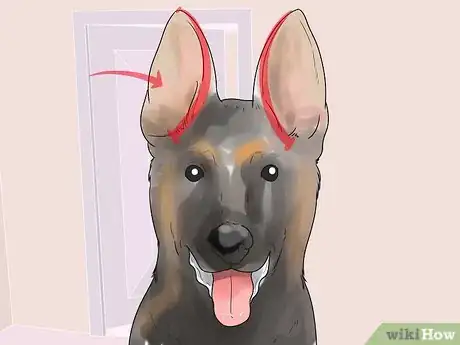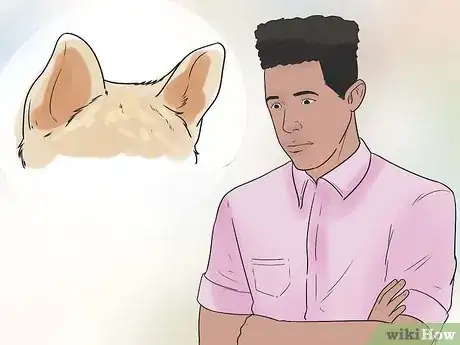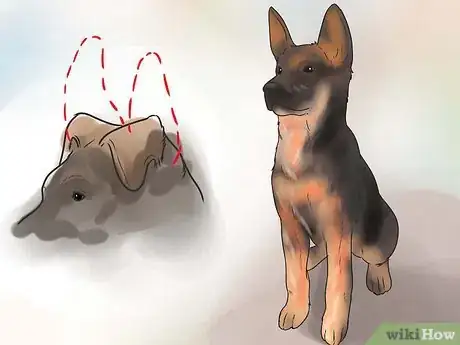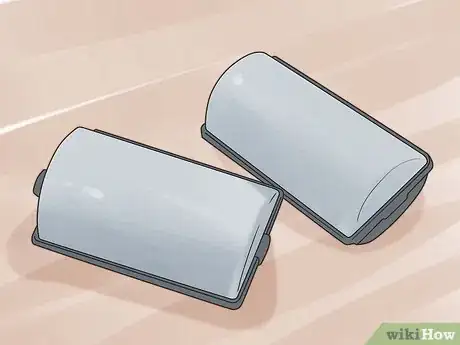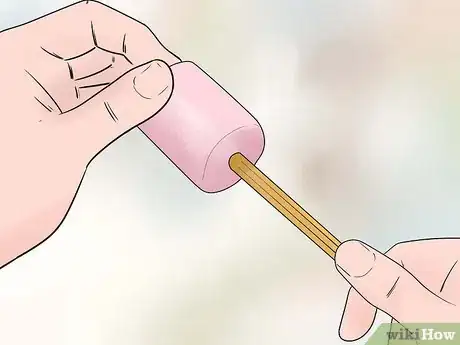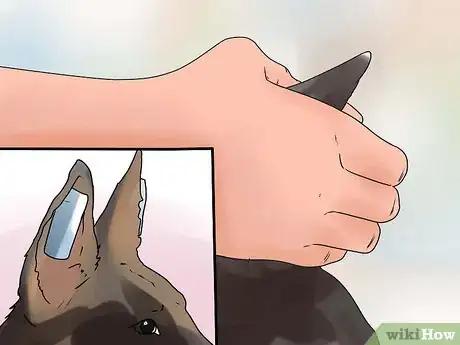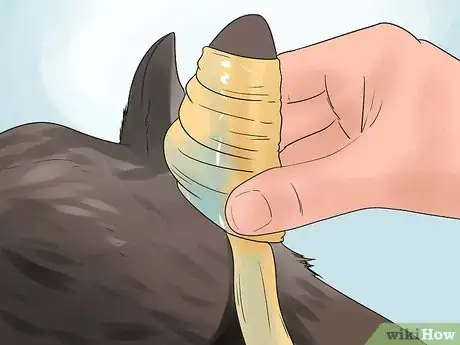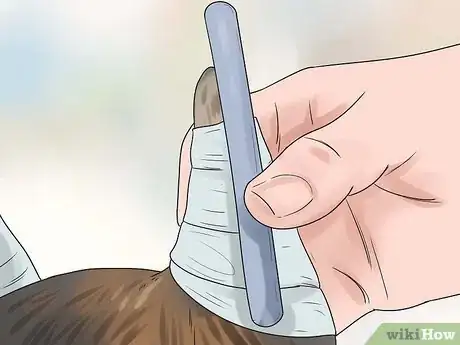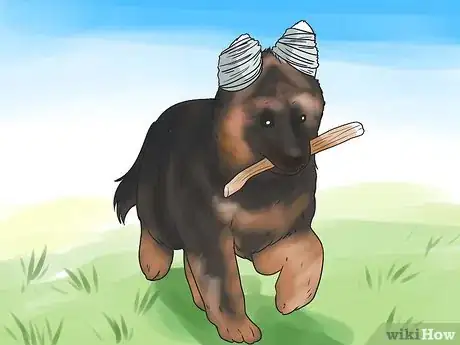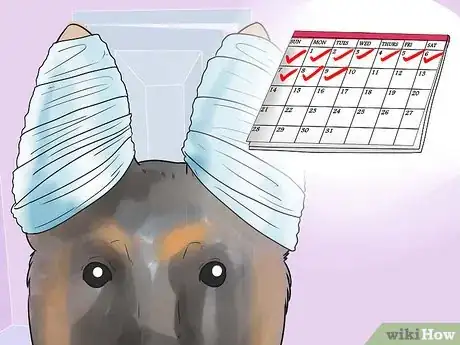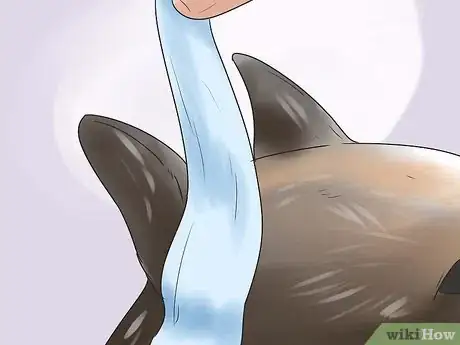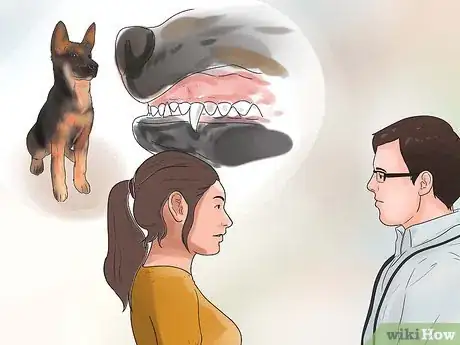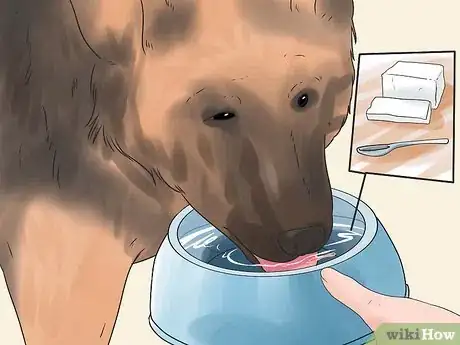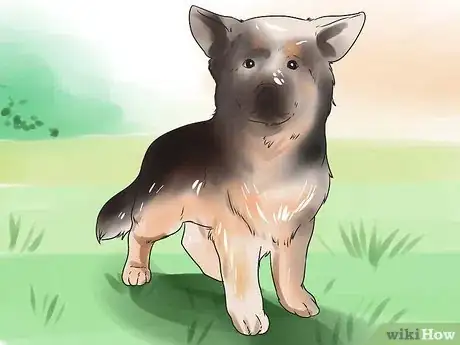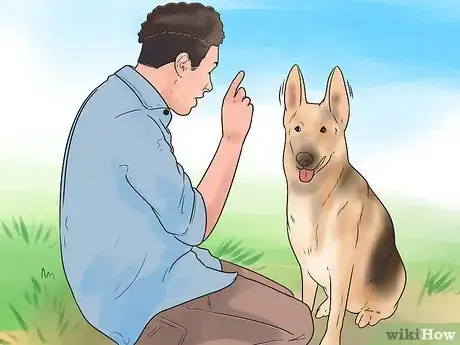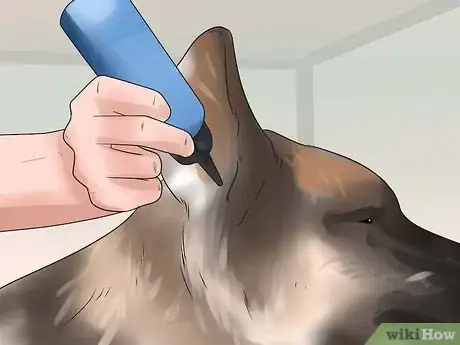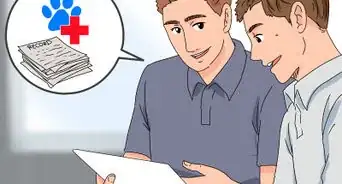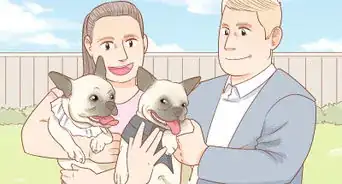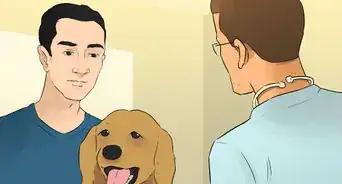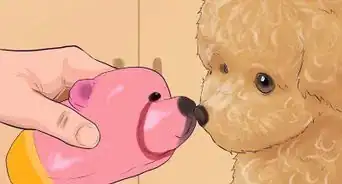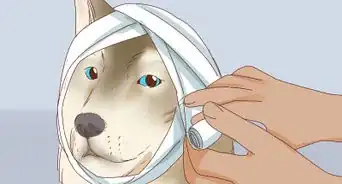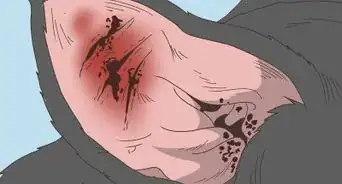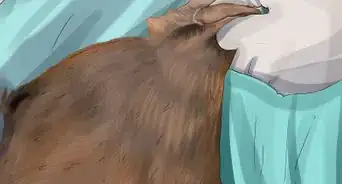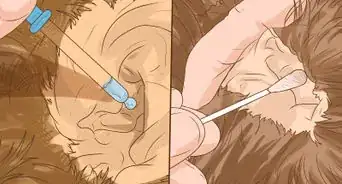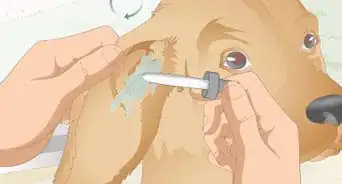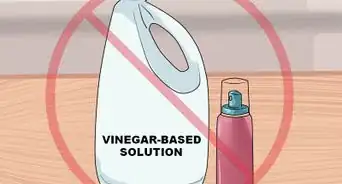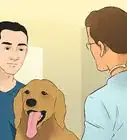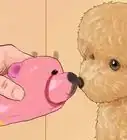This article was co-authored by wikiHow Staff. Our trained team of editors and researchers validate articles for accuracy and comprehensiveness. wikiHow's Content Management Team carefully monitors the work from our editorial staff to ensure that each article is backed by trusted research and meets our high quality standards.
This article has been viewed 371,075 times.
Learn more...
The ears of your German shepherd puppy can be curious things to observe. His ears may switch between standing up and flopping over for the first year of his life, seemingly without much rhyme or reason. His ears may eventually stand up all on their own, or they may need some help from you to stand up straight. Even though someone with experience should tape up German shepherd puppy ears,[1] you can tape your own puppy's stubborn ears if you feel comfortable doing so.
Steps
Deciding to Tape Your Puppy's Ears
-
1Look at the structure of your puppy's ears. Simply put, not all German shepherd puppy ears are created equal. For example, thin ears that do not have much cartilage may not be stiff enough to stand upright on their own. On the contrary, thicker ears probably have enough cartilage and muscle development to stand up more easily.
- Ears that are widely spaced on your puppy's head may have a harder time standing upright.
- Smaller ears are more likely to stand up naturally than larger ears.
-
2Decide if upright ears on your puppy is important to you. Although it is the breed standard for German shepherds to have upright ears,[2] it is not necessary that your own puppy meet the breed standard. It is your personal preference whether your puppy should meet this standard.
- Due to their structure, upright ears are less prone to ear infections than floppy ears. Upright ears also do not have be cleaned as frequently as floppy ears (about once a month versus once a week).[3]
- Floppy ears tend to trap more moisture than upright ears, are therefore more prone to ear infections.[4]
- Be aware that not all German shepherd puppy ears will stand up. This is known as “soft ear” and could lead to ear problems.[5]
- Consult with your veterinarian or a German shepherd breeder if you are undecided on whether to tape your puppy's ears.
Advertisement -
3Wait to see if puppy's ears stand up naturally. Even with the option of taping, it is preferable for German shepherd puppy ears to stand up without assistance. You cannot wait indefinitely for your puppy's ears to stand up. Some may still have a floppy ear by the time they are 8 months., though—if they have not stood completely up by the time he is 7 to 8 months old, they are unlikely to stand up at all.[6]
- Be mindful that it is not possible to have 100% certainty that your puppy's ears will stand up naturally on their own.
- Some puppy's ears will be upright on their own in as few as 8 weeks. For other puppies, it might take as long as 6 months before their ears stand upright.[7] Also, one ear may stand upright before the other.
Taping Your Puppy's Ears
-
1Obtain the necessary supplies. Fortunately, you will not need many supplies to tape your German shepherd puppy's ears. In fact, you may already have some of the supplies at home. One of the supplies you will need is women's large foam rollers.[8] Rollers are available at your local pharmacy.
- The large size of rollers is usually pink, but do not rely on color to choose the correct size.
- Alternatively, you could use small pipe insulation tubing, which is available at home improvement stores. If you choose to use tubing, it should be about the same diameter as a large foam roller.[9]
- You will also need tape. The type of tape to use is very important! The best type of tape to use is white surgical tape (two-inch wide 3M Micropore tape), which is available at your local pharmacy.[10] Masking tape is another option, but is less preferred than surgical tape.
- Do not use duct tape or electrical tape. These types of tape are too adhesive and could damage your puppy's ears.
- You will also need glue (Skin Bond adhesive is recommended) and one or two unsharpened # 2 pencils.[11] False eyelash glue is not recommended.
- A popsicle stick will be needed to serve as a 'bridge' between your puppy's ears after you have taped them.[12]
-
2Prepare the foam roller for placement in your puppy's ear. Remove the plastic rod from the middle of the roller. Next, insert the unsharpened pencil about 1 inch into the middle opening of the roller—this will help you stabilize the roller when you position it inside the ear. You will then apply the glue about three-fourths of the way around the circumference of the roller.[13]
- Apply enough glue to coat the roller, but not so much that the glue oozes or drips from the roller. If you apply too much, the glue could run into your puppy's ear canal and potentially cause irritation. The glue could also drip onto your hands, which would make it difficult for you to easily maneuver your hands.[14]
- If you are uncomfortable with the glue, you could cover the roller with tape, sticky side out. If you prefer to use the tape, you will not need to put the pencil in the roller.[15]
-
3Position the foam roller inside your puppy's ear. Proper positioning of the foam roller is important so that you do not block your puppy's ear canal and impair his ability to hear. Place the roller inside the ear near the bottom half of the ear flap. Make sure there is two fingers' worth of space between the bottom of the roller and your puppy's head.[16]
- It may help to gently press the roller into the inside of the ear so that the glue or tape on the roller touches the ear.
-
4Tape the ear around the roller. Holding the pencil end of the roller, wrap the ear around the roller. While continuing to hold the pencil end, start taping at the top of the ear in a circular motion and work your way down. Use firm pressure when taping the ear, but be careful not to tape the ear too tightly—not only would this be uncomfortable for your puppy, but it may also cut off circulation to the ear.[17]
- Remove the pencil with a gentle upward motion before you finish taping the ear.[18]
- Even if one ear is already standing upright, it is ideal to tape up both ears.
-
5Stabilize both ears. Place the popsicle stick behind the top of both ears and secure it to each ear with additional tape or glue. The popsicle stick will act like a bridge between the ears to keep them upright and stabilized while they are taped.[19]
-
6Distract your puppy. Your puppy will probably want to start messing with his ears as soon as you finish taping them up. Distracting him for about five minutes will give the glue and/or tape time to set. You can distract him with food or a few minutes of playtime.[20]
- Puppies naturally have a lot of energy, so keeping your puppy still while the glue and/or tape sets will probably not work very well. Distracting him with activities that he enjoys will divert his attention from his ears, at least temporarily.
-
7Keep the ears taped up for 10 to 14 days. Your puppy's ears may need up to two weeks to remain stabilized in the upright position. During this time, your puppy will probably manage to remove the popsicle stick and might even start unraveling the tape from his ears. This is most likely to happen in the first 24 hours after you have taped his ears.
- If you notice the tape unraveling, or that the popsicle stick has come off, make the fixes where needed.
- Cover up his ears with a plastic bag if it is raining outside when it's time for your puppy to go out.
- Consider taking the tape off after seven days to see if the ears will stand up on their own. If not, re-tape the ears.[21]
-
8Remove the tape and popsicle stick. It is recommended to use an adhesive remover to remove the tape from your puppy's ears.[22] This product can be found at your local home improvement store. Following the instructions on the adhesive remover bottle, gently and slowly remove the tape and foam roller from your puppy's ears.
- Do not forcefully rip off the tape or rip out the roller. Not only will this be painful for your puppy, but you may also end up damaging the inside of your puppy's ears.
- Do not be worried if your puppy's ears do not stand exactly upright when you remove the tape and foam roller. His ears may be a little weak after being taped, but will strengthen over time.[23]
Caring for Your Puppy's Ears Before Taping
-
1Do not tape up his ears too soon. It is recommended to wait until after your German shepherd puppy's adult teeth have started to come in (around 3 to 5 months) to tape up his ears. You may even want to wait until after he has finished teething (around 7 months) before taping up his ears. Taping his ears too soon may end up damaging his ears to the point where they will not stand up on their own.
- Because calcium is being diverted from your puppy's ears to his teeth during teething, his ears will probably switch back and forth between standing up and flopping down.[24]
- Talk with your veterinarian if you are unsure of when to start considering taping up his ears.
-
2Provide your puppy with extra calcium. During the teething process, your puppy's ears will probably lose calcium. Without enough calcium, your puppy's ears may have a harder time standing upright. Giving him a little extra calcium in his diet (1 tablespoon of cottage cheese or yogurt per meal) will help to replace this calcium deficiency.
- Even though it may tempting to do so, do not give your puppy calcium supplements. The extra calcium could deposit in his bones and lead to long-term orthopedic problems, such as bone spurs and arthritis, later in life.
- Consult with your veterinarian on ways to provide your puppy with extra calcium.
-
3Keep your puppy in good health. Your puppy's overall health plays an important role in the health and strength of his ears. One thing you should do is keep your puppy up to date on his vaccinations and deworming schedule. You should also feed him a well-balanced, high-quality puppy food.[25]
-
4Encourage your puppy to use his ear muscles. If you notice that his ears stand up one day and then flop down the next, encourage your puppy to use his ears more and more. The more he perks his ears up, the stronger his ear muscles will become and the more likely his ears will stand upright. Try making interesting noises and sounds (e.g., honking a car horn, clapping your hands, ringing a bell) to get your puppy to perk his ears up.[26]
- Giving him chew toys and bones to chew on will also be helpful. The chewing motion strengthens the muscles at the base of the ear.
-
5Protect your German shepherd puppy's ears from damage. Damage to your puppy's ears can prevent them from being able to stand upright. Contrary to popular belief, massaging the base of your puppy's ears will not encourage them to stand upright. In fact, massaging, rubbing, and playing with your puppy's ears can actually damage them.
- If your puppy sleeps in a crate, try to keep him from sleeping with his head against the side of the crate. This sleeping position can damage his ears.
- Puppies can pull and tug on each other's ears. If you have other puppies, keep an eye on them to make sure they leave each other's ears alone as much as possible.
- Clean your puppy's ears regularly. Ear cleaners are available at your local pet store. Talk with your veterinarian for advice on how to clean your puppy's ears.
Community Q&A
-
QuestionWhy won't my German Shepherd's ears stay up?
 Community AnswerWhat age is your German Shepherd? If it's young, they'll probably stay up when it grows up. Some German Shepherds have naturally floppy ears, especially as a puppy. You shouldn't be worried.
Community AnswerWhat age is your German Shepherd? If it's young, they'll probably stay up when it grows up. Some German Shepherds have naturally floppy ears, especially as a puppy. You shouldn't be worried. -
QuestionMy pup is 6 months old, if I can't get the items required to tape his ears what can I use?
 Community AnswerYou can go to the vet and ask for the wraps. I recommended researching because if you place it wrong, you could SEVERELY injure the dog.
Community AnswerYou can go to the vet and ask for the wraps. I recommended researching because if you place it wrong, you could SEVERELY injure the dog. -
QuestionMy puppy is 4.5 months old and her ears are flopping. Should I tape them?
 Community AnswerOnly a vet will know your dog's unique situation best. However, as dog's adult teeth grow in, its body moves calcium from the ears to the teeth, which can cause the ears to flop. They should go up again naturally.
Community AnswerOnly a vet will know your dog's unique situation best. However, as dog's adult teeth grow in, its body moves calcium from the ears to the teeth, which can cause the ears to flop. They should go up again naturally.
References
- ↑ http://www.askavetquestion.com/answer_np.php?id=5273-floppy-ear-in-german-shepherd
- ↑ http://www.total-german-shepherd.com/GermanShepherdeartaping.html
- ↑ http://www.whole-dog-journal.com/issues/7_10/features/Canine-Ear_15661-1.html
- ↑ http://www.whole-dog-journal.com/issues/7_10/features/Canine-Ear_15661-1.html
- ↑ http://www.total-german-shepherd.com/GermanShepherdeartaping.html
- ↑ https://leerburg.com/tapingears.htm
- ↑ http://www.total-german-shepherd.com/GermanShepherdeartaping.html
- ↑ http://www.total-german-shepherd.com/GermanShepherdeartaping.html
- ↑ http://www.total-german-shepherd.com/GermanShepherdeartaping.html
- ↑ https://leerburg.com/tapingears.htm
- ↑ http://www.total-german-shepherd.com/GermanShepherdeartaping.html
- ↑ https://leerburg.com/tapingears.htm
- ↑ http://www.total-german-shepherd.com/GermanShepherdeartaping.html
- ↑ http://www.total-german-shepherd.com/GermanShepherdeartaping.html
- ↑ http://www.total-german-shepherd.com/GermanShepherdeartaping.html
- ↑ http://www.total-german-shepherd.com/GermanShepherdeartaping.html
- ↑ http://www.total-german-shepherd.com/GermanShepherdeartaping.html
- ↑ http://www.total-german-shepherd.com/GermanShepherdeartaping.html
- ↑ https://leerburg.com/tapingears.htm
- ↑ http://www.total-german-shepherd.com/GermanShepherdeartaping.html
- ↑ https://leerburg.com/tapingears.htm
- ↑ http://www.total-german-shepherd.com/GermanShepherdeartaping.html
- ↑ https://leerburg.com/tapingears.htm
- ↑ http://www.total-german-shepherd.com/GermanShepherdeartaping.html
- ↑ http://www.total-german-shepherd.com/GermanShepherdeartaping.html
- ↑ http://www.total-german-shepherd.com/GermanShepherdeartaping.html
About This Article
Before you tape up your German shepherd puppy’s ears, keep in mind that ears that are thin or widely spaced apart might never stand upright. Also, try to wait until your puppy is at least 6 months old since sometimes it just takes a while for a German shepherd's ears to stand upright on their own. To tape your puppy's ears, attach a large foam hair roller to the inside of them with surgical tape, making sure you're not blocking the ear canal. Then, place a popsicle stick behind the top of each ear and secure it with tape. To learn how to care for your puppy while its ears are taped, keep reading!
